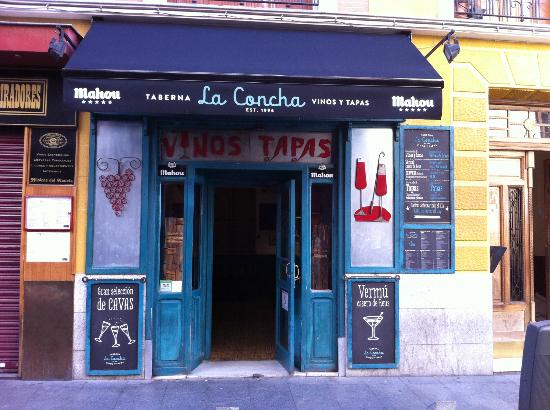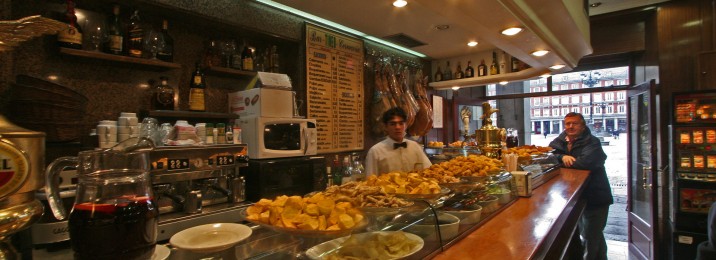What’s New in Tapas – Madrid
“Madrid-Plaza Mayor-Tapas bar” by Brian Snelson - Flickr: Lunch. Licensed under CC BY 2.0 via Wikimedia Commons
As in Barcelona, the tapas of Spain’s capital city, Madrid, tend to push boundaries of place and time – especially in the relatively new gastrobars of La Latina. This part of the city is the historic core of Madrid, thought to be its original centre of expansion. Today, it’s also home to some of the best new tapas bars in the city, particularly on Calle Cava Baja. Chefs here no longer stick to traditional dishes rooted in the regional culture and increasingly look further afield for their inspiration and how we love that!.
Once lined with traditional tapas bars serving typical Madrileno cuisine (such as pig’s cheek, huevos rotos [fried potato with egg and ham], croquettes, beef jerky, boquerones [anchovies in vinegar], tortilla of egg and potato, and of course, patatas bravas), Calle Cava Baja is now a centre of avant-garde culinary thinking. One of the very first bars to lead this trend was Casa Lucas, founded in 1997. Their flavors today are somewhat traditional but their techniques are certainly not. A key fixture on their menu is the savoury mousse, which comes in various flavors, including the polenta mousse to accompany chicken, and the squid ink mousse for bacon and calamari.
Other bars on Cava Baja push the envelope in a similar direction. Juana La Loca has beef carpaccio with an olive oil

Taberna La Concha, Madrid
sorbet, as well as salmon topped with Rice Krispies, while Taberna La Concha takes a different route by twisting conventional ingredients to an Asian flavor palette; prawns and hake are served in a green curry, while salmon is marinated in sake, vanilla, and citrus.
Elsewhere in La Latina, such as at Taberna Matritum on Cava Alta (parallel to Cava Baja), Japanese-style tataki bonito is served with a Spanish-style ajoblanco (white garlic) sauce, and a similar fusion is achieved by combining braised octopus and salmon eggs with a miso flavoring. Likewise, Txirimiri on Calle Humilladero presents traditional ingredients like cod and peppers in a non-traditional tempura style.
In fact, Oriental fusion seems to be a common sight all over Madrid. Beyond La Latina, at Olé Lola on Calle San Mateo, for instance, you’ll find butter fish sashimi and chicken lollipops with soy and honey. Of particular note here is the creative way in which the food is served, as well as the way it tastes. For example, their black ribbon tagliatelle with sautéed squid, sesame and ginger is served with chunky wooden chopsticks in a cardboard takeaway container.
One possible reason for this trend is that, in a credit crisis, people have been increasingly unwilling to pay a premium for good restaurant food, yet they still expect restaurants to win their custom. Rather than focusing on sourcing the most expensive ingredients, therefore, many restaurateurs tend instead toward developing creative, exciting dishes that don’t cost too much but are nonetheless impressive. Drawing on international influences is one way of doing this.
That said, it is also very common for the city’s new wave of gastrobars to re-imagine Spanish favorites. Estado Puro
This photo of Estado Puro is courtesy of TripAdvisor
on Plaza Cánovas del Castillo, founded in 2008 by Paco Roncero, is considered to have been at the forefront of the most recent culinary developments, and is playful in its re-interpretation of classic tapas. Among their most talked about is the Tortilla Siglo XXI (21st Century Tortilla), which de-constructs the ubiquitous potato omelette and serves its constituent parts layered like a trifle in a glass. Other examples are their Galician octopus lollipops and their beetroot gazpacho with cod croutons.
Less playful re-imaginings of traditional favorites tend to focus on contemporary haute cuisine. At the chic La Cabrera, Sergi Arola serves meatballs with caramelized foie and truffle cream, and at Baco y Beto on Calle Pelayo, they serve their foie in port sauce and caramelized bananas a sure favorite of ours.
There are of course still plenty of traditional tapas bars in Madrid, but what this new trend demonstrates is that tapas can adapt with the times; it can accommodate the demands of new customers (from locals to tourists) and it can navigate the constraints of difficult financial climates. It shows, above all, that tapas isn’t going anywhere – no matter what it looks like.


No comments
You can be the first one to leave a comment.